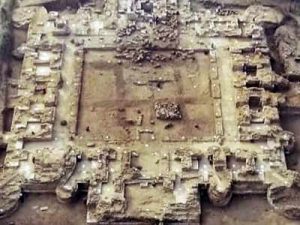
With the Taliban’s takeover of Afghanistan last month, many of the nation’s Buddhist cultural treasures are in danger, according to archaeologists.* One site of particular importance—in part because it has yet to be fully excavated—is Mes Aynak, an ancient Buddhist city that flourished from the 1st–7th century CE.
The city, whose name means “little source of copper” in the Pashto language, is known to contain a vast complex of Buddhist buildings, including monasteries, temples, and stupas, along with fortifications, commercial buildings, and residences. However, the ancient Buddhist artifacts themselves sit atop even older remains that date back to 3,000 BCE, the early Bronze Age. Along with these discoveries is a Zoroastrian fire temple, suggesting layers of archeological wealth lying just below the surface.

Despite this historical heritage, the region has long been unsafe for archaeological work— a fact that was underscored in 2018, when a roadside bomb killed Afghan archaeologist Abdul Wahab Ferozi near Mes Aynak.** Nevertheless, numerous Buddhist artifacts have been recovered and restored over the last 20 years, giving hope to preservationists that work might continue.***
Philippe Marquis, head of the Délégation archéologique française en Afghanistan (DAFA), which supported the country’s former Ministry of Information and Culture in excavating the site, recently said: “The data that we have collected from Mes Aynak is huge, but what we can expect is even bigger. We still have a lot to do.” (The Art Newspaper)
In 2007, the Chinese conglomerate China Metallurgical Group (MCC) signed a 30-year lease with the Afghan government—then led by the US-backed president Hamid Karzai—to mine rich copper reserves also contained at the site. The deal, worth an estimated US$3 billion, remains the largest private foreign investment in Afghanistan since 2001 and presents China and Afghanistan with an opportunity to strengthen bilateral ties, with the US and its allies now out of the country.

Since 2012, people concerned about the cultural and Buddhist heritage of the site have been petitioning to halt the mine or at least significantly delay mining work so that archeologists can carefully excavate the area. A Change.org petition started in that year that collected 90,815 signatures from around the world:
1. We insist that the Mes Aynak mining project be conducted in accordance with international standards in a transparent manner that will safeguard public health, and ensure maximum protection for cultural heritage and the environment. International standards include publication of the final mining plan, the final, approved environmental impact plan, and the consensus advisory of archaeologists to optimize restoration of the site.
2. We strongly urge the Afghan government to set up a coordinating body composed of government and mining officials, neutral experts in the fields of environmental safety, archaeology and geology, and representatives of the local population and civil society to oversee the implementation of International standards. This body shall ensure that the mining plan is followed throughout the entire life of the mine. (Change.org)
Since then, the development of the mine has stalled. However, recent statements from the Taliban suggest an eagerness to resume a strong relationship with China. In a recent interview with the Italian newspaper La Repubblica, Taliban spokesman Zabihullah Mujahid said: “China is our most important partner and represents a fundamental and extraordinary opportunity for us. It is ready to invest and rebuild our country.” (NBC News)
Brent E. Huffman, an associate professor of journalism at Northwestern University and director of Saving Mes Aynak, a documentary about Afghan archaeologist Qadir Temori’s efforts to preserve and exceavate the site in the face of mining plans and Taliban militants, has expressed serious concerns now that the Taliban is in control of the site.
Angry and heartbroken at the nightmarish situation in #Afghanistan. The incredible ancient #Buddhist city of #MesAynak (subject of my documentary @SavingMesAynak) has been taken by the #Taliban, who famously destroyed the Buddhas at Bamiyan in 2001. 1/4 pic.twitter.com/6dBRXmX9qb
— Brent E. Huffman (@Brent_Huffman) August 16, 2021
Highlighting the importance of Mes Aynak for Buddhist history, Huffman compared the site with Peru’s Machu Picchu in a recent interview with the BBC.
Similarly, Marquis noted the unique role that Mes Aynak has played in Buddhist history: “It’s the first real documentation of the relation of the Buddhist community with industrial activity. Afghanistan is very important in the history of Buddhism. We never before had the opportunity to understand the link between this community and the economical and political life of the country.” (The Art Newspaper)
* Afghan Museums Fear for Ancient Buddhist Artifacts amid Taliban Takeover (Buddhistdoor Global)
** Archaeologist Killed Near Buddhist Archaeological Site of Mes Aynak in Afghanistan (Buddhistdoor Global)
*** Exquisite Ancient Buddha Image from Mes Aynak to be Exhibited at National Museum of Afghanistan (Buddhistdoor Global)
See more
An ancient Buddhist city is perched on top of an Afghan copper reserve worth $50 billion—what will happen to it under Taliban control? (The Art Newspaper)
For China, Taliban rule in Afghanistan brings both opportunity and risk (NBC News)
Prevent destruction of ancient site of Mes Aynak and the environmental damage (Change.org)
The Buddhas of Mes Aynak (Kickstarter)
Related news reports from Buddhistdoor Global
Ancient Buddhist Artefacts from Afghanistan Restored in Japan
Is Time Running Out for the 5,000-year-old Mes Aynak Archaeological Site in Afghanistan?
Related features from Buddhistdoor Global
Buddhistdoor View: Afghanistan – Mourning a Global Failure
Buddhist Traces in Afghanistan: Reminiscences of Peace and War
The Nostalgia of 2,500 Years: Celebrating South Asia’s Buddhist Heritage
Buddhistdoor View: Heritage Conservation












